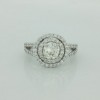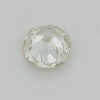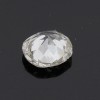Happy Stories From our customers
Read testimonials-
-
Sofia 1.03ct OEC
-
Could you please pass on my gratitude to Beth for helping me so politely with my order and answering all my questions.
Hi Sara, just wanted to let you know the ring arrived and it’s beautiful. Could you please pass on my gratitude to Beth for helping me so politely with my order and answering all my questions. Thankyou, Paula
-
Emmy Jewelry, Up Close and Personal
Last week, we showcased some of the hottest pieces worn at the Emmy Awards. But we’re not done yet! Check out some of these dazzling, up-close shots from the Emmy’s and beyond:
Gossip Girl’s Leighton Meester wore Van Cleef & Arpels’ “Two Butterfly” ring (below), a between-the-finger ring featuring round diamonds and yellow sapphires set in 18-karat yellow and white gold.

Marisol Nichols (below), of the TV show 24, wore a Katerina Maxine 18-karat white gold ring with a nearly 9-carat rubellite and diamonds ($18,400) to an Emmys party in Los Angeles.Cote de Pablo, from the TV series NCIS, donned Brumani’s Baobab 18-karat yellow gold ring (below) with brown diamonds, aquamarine and pink tourmaline ($12,001) to an awards event in California this month.

Mad Men’s Jessica Paré (below) accessorized with an Arunashi blue moonstone and black diamond “Mushroom” ring ($7,650) for an Emmys party in Los Angeles.

Thor’s Jaimie Alexander wore a Victor Velyan ring (below) with spessartite garnet ($6,140) to a soiree in West Hollywood.
House’s Jennifer Morrison (below) wore KumKum’s Paradise night black zircon and sterling silver ring ($599) outside of the Jimmy Kimmel Live studios in Los Angeles this month. -
I now have two generations of Schubachs sparkling on my finger.
Hi Joe,
Wow! Thank you so much for working with my sneaky husband on surprising me with the new diamond. I am still blown away! It’s absolutely beautiful! As I gaze down at my finger, I now have two generations of Schubachs sparkling on my finger. My original rings came from your dad. But, that was thirty years ago. J
-
The Cadmium Debate Continues
What is cadmium? Cadmium is a rare metallic element found in small deposits on almost every continent. It has a number of uses and it can be expensive due to its rarity. Cadmium is also toxic and should be handled with care. So how does it play part in the jewelry industry? Cadmium is often used in children’s jewelry. Health concerns have been raised and states continue to decide on appropriate guidelines:
The U.S jewelry industry wants states to overturn laws that limit the toxic metal cadmium in children’s trinkets and adopt new voluntary guidelines it helped create, saying stricter rules in several states create chaos for manufacturers and importers.
Persuading legislators to reopen the issue won’t be an easy sell: Many consumer and environmental advocates say the new guidelines weaken protection of children’s health.
While the voluntary rules have the support of federal regulators, states that passed much stricter limits over the past year would have to backtrack and allow higher levels of a metal that can cause cancer.
That didn’t sound likely Monday.
“Maryland ought to set whatever standard we feel is correct,” said Delegate James Hubbard, a Democrat who successfully sponsored the nation’s toughest cadmium-in-jewelry limits this spring. “We made a judgment call based on what we felt was in the best interest of the people we represent.”
A jewelry industry that has been hammered by more than a year of recalls and legal setbacks does have some momentum, now that the rules it drafted were passed last week by the respected organization ASTM International, which sets voluntary rules for a range of goods. Industry’s goal is to replace the current patchwork of regulation with a unified standard.
“Our whole mission in this is to have standards that are not floating in quicksand,” said Brent Cleaveland, head of the ASTM subcommittee that wrote the rules and executive director of the Fashion Jewelry and Accessories Trade Association. He described the limits he oversaw as “way more conservative than necessary” to protect kids’ health.
Cleaveland says his next move is to press legislatures in states that have set limits to reopen the issue and adopt the voluntary standards. If that succeeds, Cleaveland would then ask Congress to pass legislation to make the voluntary standard national law.
If the industry lobbying effort fails, state limits that are much tougher than the voluntary rules will effectively remain the national standard. That’s because manufacturers that sell in places like California and Maryland would need to comply with limits there, and wouldn’t create different products for the rest of the country.
Mandatory limits adopted over the past year already deter use of the heavy metal, which over time can also cause bone and kidney diseases, though there have been no documented deaths or serious injuries.
-
C.P. Fancy Yellow Radiant Clarity Enhanced Diamond
-
The Keys to Finding a Comfortable Ring
Sure, we all want a dazzling stunner of a ring. But often comfort is an afterthought…until you start wearing it! And if you’re wearing a wedding band, my friend, you’re wearing it for a looong time (at least we hope!) So here are a few tips to finding a wedding band or engagement ring that fits comfortably and well.
1. The inner shape. A comfortable wedding band usually has soft, rounded edges. There should be a slight curve on the inside ring which increases comfortability. This doesn’t mean that a flatter band always means discomfort – a well-constructed flat band can feel equally comfortable. Hence the importance of trying one of our wedding bands on in our Scottsdale, Arizona showroom!
2. A comfort fit ring. These rings are not lacking in style; they are simply constructed with fit in mind. Comfort fit wedding bands are perfect for people with an active lifestyle or hands-on jobs.
3. A good fitting. When you try on a wedding band, it’s important to keep it on for a while. Often rings feel just fine at first, but as you probably know, your finger sizes change slightly throughout the day. Spend some time with your wedding band. Move your fingers about. Even if you just notice the ring on your finger, it could be a problem for some. It may not hurt per se; it could just feel too weighty or cumbersome. The idea is to find a band that is a natural extension of you and your lifestyle so spending some time wearing it before purchasing is a smart move.

Style 6887WB Yellow Gold Comfort Fit Band With Hammered Center And Polished Sides
14kt yellow gold comfort fit wedding band, hammered center with high polished sides, 8mm wide.

Style 6797WB
Comfort Fit Titanium Band With Satin Finished Center
Titanium comfort fit wedding band with satin finished center, 6mm wide.

Style 6795WB
Black Titanium And 18kt White Gold Comfort Fit Band
Black titanium/18kt white gold comfort fit band, 7mm.
Metal: Black Titanium/18kt White Gold
Ring size: 4 – 13
Style 7129WB
Black Titanium/18kt White Gold Comfort Fit Band With Diamond
Black titanium/18kt white gold comfort fit wedding band with a .16ct tension set diamond, 6mm wide.
Metal: Black Titanium/18kt White Gold
Stone size: .16ct
Ring size: 4 – 13 -
J.T. Three Stone Ring
-
The service I received and the craftsmanship of the ring are truly exceptional.
Dear Joe,I wanted to take a moment to thank you and Sara for all of your help in acquiring my new platinum engagement ring. The service I received and the craftsmanship of the ring are truly exceptional. K is delighted with it, and I’ve already had the pleasure of recommending Joseph Schubach Jewelers to friends and family. K’s birthday and Christmas are both coming up quickly and I look forward to doing business with you in the future.Wishing you all the best,T





























